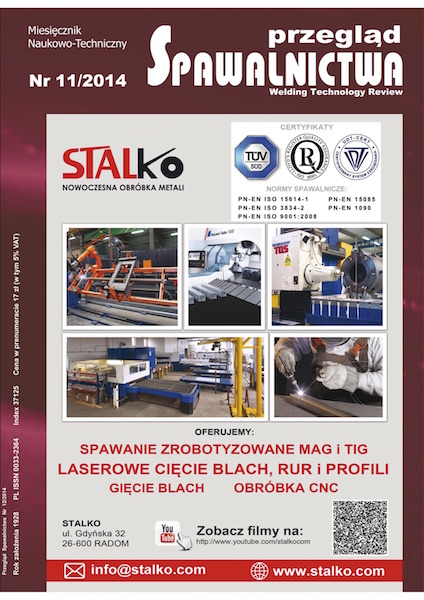Detekcja i monitorowanie przyrostu pęknięć zmęczeniowych z wykorzystaniem fal sprężystych generowanych przez przetworniki PZT
Main Article Content
Abstract
Streszczenie
w pracy zaprezentowano wybrane wyniki monitorowania struktury samolotu PZL130 Orlik TC II w trakcie pełnoskalowej próby zmęczeniowej. w strukturze samolotu rozmieszczono sieć czujników piezoelektrycznych PZT, podłączoną do dedykowanego systemu komputerowego, umożliwiającego zdalne monitorowanie konstrukcji. W pracy przedstawiono opis wielokanałowego urządzenia rejestrującego sygnały uzyskane z przetworników piezoelektrycznych oraz wyniki uzyskane w wybranych punktach pomiarowych na różnych etapach rozwoju pęknięć zmęczeniowych. Proponowane sposób monitorowania konstrukcji oparty jest na tzw. wskaźnikach uszkodzeń zachowujących znikomą informację o przebiegu czasowym rejestrowanych sygnałów, związanych z ich energią. w pracy przedstawiono opis wykorzystywanych charakterystyk sygnałowych oraz sposobów wnioskowania o obecności i rozwoju pęknięć zmęczeniowych. Opracowane techniki zostały zweryfikowane na podstawie danych uzyskanych w trakcie pełnoskalowej próby zmęczeniowej. Uzyskane wyniki potwierdzają zalety korzystania z systemu monitorowania uszkodzeń w oparciu o przetworniki PZT, zwłaszcza w lokalizacjach trudno dostępnych dla standardowych technik badań nieniszczących.
Abstract
This paper presents an approach to the health monitoring of the PZL130 TC II Orlik aircraft structure during the full scale fatigue test (FSFT). A network of PZT piezoelectric transducers was assembled on the aircraft structure and a dedicated hardware enabling remote control and programmed measurement performance was elaborated. A multichannel acquisition system of large dataset of measurements from the ‘hot-spot locations of the sensors on different stages of the fatigue tests is described in the paper. In the adopted approach a set of Damage In- dices (DIs), carrying marginal signal information content and correlated with the total energy received by a given sensor are proposed. The paper provides the description of elaborated techniques for the signal processing and inference about the damage presence. Damage detec- tion capabilities are exemplified by data collected from selected network nodes where damages were found during the project run and the results of their monitoring will be highlighted. The necessity of the use of nDE assisted technology for early damage detection has been proven within the project, especially for the ‘hard to access locations in the aircraft structure.
Downloads
Article Details
Creative Commons CC BY 4.0 https://creativecommons.org/licenses/by/4.0/
Welding Technology Review (WTR) articles are published open access under a CC BY licence (Creative Commons Attribution 4.0 International licence). The CC BY licence is the most open licence available and considered the industry 'gold standard' for open access; it is also preferred by many funders. This licence allows readers to copy and redistribute the material in any medium or format, and to alter, transform, or build upon the material, including for commercial use, providing the original author is credited.
References
J. Lewitowicz, Podstawy Eksploatacji Statków Powietrznych T-1, Wydawnictwo ITWL, Warszawa, 2001.
Serwis internetowy, national Institute for Occupational Safety and Health, http://www.cdc.gov/nIOSH/.
Aging of U.S. Air Force Aircraft, Final Report, Publication nMAB-488-2, National Academy Press, USA, Washington D.C. 1997.
NDE of Cracks in Aircraft, nTIAC SR-98-04, USA, Texas 1998.
K. Dragan, S. Klimaszewski, In-Service nDI of Aging Helicopters Main Rotor Blades Used In Polish Armed Forces, 9th Joint FAA/DoD/nASA Aging Aircraft Conference, Atlanta, 06÷09 marca, 2006.
W. Rücker, SAMCO Final Report 2006, Guideline for Structural Health Monitoring, Federal Institute of Materials Research and Testing (BAM), Berlin 2006.
S.W. Doebling, Ch.R. Farrar Daniel, Damage Identification and Health Monitoring of Structural and Mechanical Systems from Changes in Their Vibration Characteristics: A Literature Review, Los Alamos national Laboratory, Los Alamos 1996.
K. Dragan, S. Klimaszewski, In-service Flaw Detection and Quantification on the MiG-29 Composite Vertical Tail Skin, 9th European Conference on non-Destructive Testing, Berlin, 25-29 września 2006.
K. Dragan, M. Dziendzikowski, T. Uhl, The development of the non-parametric classification models for the damage monito- ring on the example of the ORLIK aircraft structure, Key. Eng. Mat. Vol. 518, 2012.
K. Dragan, M. Dziendzikowski, S. Klimaszewski, S. Kłysz, A. Kurnyta, Energy Correlated Damage Indices in Fatigue Crack Extent Quantification, Key. Eng. Mat. Vol. 570, 2013.
Z. Su and L. Ye, ‘Identification of Damage Using Lamb waves, Springer-Verlag, Niemcy, 2009.
K. Graff, ‘wave motion in elastic solids, Oxford University Press, Oxford, 1975.
www.symost.pl
